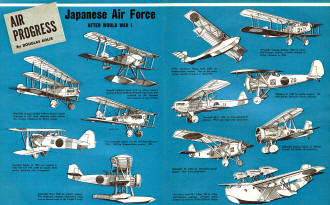|
Japanese involvement in
World War I is generally not as well known as it is for World War II. The
surprise attack at
Pearl Harbor
on December 7, 1941, has permanently implanted itself as one of the nation's
most memorable events, and obviously the U.S. and Japan were mortal enemies
until the Japs'
unconditional surrender on September 2, 1945, following the bombings of
Hiroshima and Nagasaki. Conversely,
Japan was
part of the Allied (aka
Entente)
powers in World War I, and was considered an ally of America, Great Britain,
Italy, and France (primarily) in their war against Germany, Austria, and the
Ottoman Empire. It was one of those "the enemy of my enemy is my friend"
scenarios. Japan played a major role in barricading German sea lanes
in the South Pacific. Being a relatively small island nation, Japan's air force
consisted of many amphibious airplanes and floatplanes. This Douglas Rolfe
feature in a 1954 issue of Air Trails magazine reviews many of the
Japanese aircraft in the era following World War I.
See the next month for
Air Progress: Japanese Air Force World War II Fighters
Air Progress - Japanese Air Force After World War I
 By Douglas Rolfe By Douglas Rolfe
Sopwith seaplane Scout (110 hp rotary engine). Several of these modified Schneider
Cup racers were acquired by the Japanese Naval Service at the end of WWI.
Mitsubishi torpedo bomber (450 hp Napier engine) appeared in 1921 when Japanese
naval aviation was strongly influenced by British design.
First Jap-built fighter was this Nakajima-Nieuport 29c-1. (300 hp Hispano-Suiza
engine.) 1922.
Kawasaki fighter of 1932 was reputed to make 205 mph with a 500 hp engine. Note
curious interplane strut arrangement.
Kawanishi 90-11 (450 hp Jupiter engine). This shipboard catapult observation
plane was an obvious copy of the Vought Corsair.
Mitsubishi torpedo bomber (450 hp Mitsubishi-Hispano engine). Another example
of British influence in 1928.
Tellier two-place flying boat (200 hp Hispano-Suiza engine). One of the many
foreign aircraft acquired in 1918-1919.
Nakajima 91 (450 hp Jupiter engine). This 1933 fighter betrayed French influence.
Kawasaki 88-11 (450 hp Kawasaki-B.M.W. engine). 1933 long-range army observation.
Nakajima biplane fighter of 1932-33 showed U.S.-British characteristics.
Mitsubishi 92 (420 hp Mitsubishi-Jaguar engine).1932 army observation.
Hiro Navy Yard 90-1 (three 700 hp Mitsubishi-Hispano engines). All-metal patrol-bomber
was mixture of Short/Dornier design.
The Japanese air arm dates from about 1912 and was orginaly formed as one body
without distinction between naval and military wings. It was later re-organized
to include separate naval and military forces. Early equipment was entirely foreign
and included Curtiss and Farman bi-planes plus few Deperdussin monoplanes. After
World War I a number of fighters were purchased, but it was about this time that
a British mission arrived, and for some while thereafter a strong British
influence became apparent, particularly in Japanese naval aircraft. There was also
a marked German influence. The Japanese continued to rely on foreign-built aircraft
until about 1921, and even after they commenced to produce their own planes these
were mostly copies of foreign types. Then for a long period of time the Nipponese
maintained great secrecy about their air force - and in 1941 they flung hundreds
of first-class aircraft against us which few realized they had the capacity to design
and produce... The second part will take up some of the more interesting and formidable
types employed in World War II.
Posted January 2, 2021
|